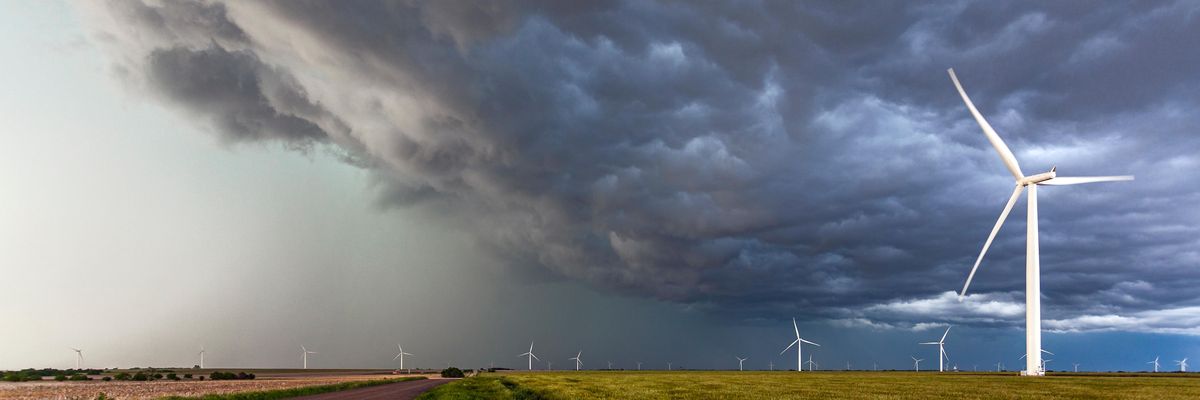The people of Nebraska "deserve a livable future with less water and air pollution, more sustainable jobs, and democratic control over their energy sources."
So declares a report released Tuesday by the Institute for Policy Studies (IPS) that urges the landlocked U.S. state to take full advantage of its vast wind energy potential and ditch its climate-wrecking reliance on coal.
Entitled Rain and Sunshine and Wind How an Energy Transition Could Power Nebraska, the new publication details how the state is ripe for a just energy transition and offers a roadmap for how to get there.
"Nebraska has the fourth-highest wind energy potential among all U.S. states, and is served exclusively by publicly-owned utilities," said report co-author Basav Sen, climate policy director at IPS. "This makes the state uniquely positioned to transition to wind energy and other forms of renewable energy in a just and equitable manner."
The state's current energy system, according to the report, is simply unsustainable.
Data from 2020 shows that just over half of Nebraska's energy comes from coal, which "has and will continue to pose a real threat to communities." The report points to toxic air pollution from coal power plants, which are disproportionately located in communities of color.
There's also the broader climate impacts of continuing to rely on fossil fuels, as well as locally felt consequence including flooding, droughts, and adverse impacts on soil.
Transitioning to a wind-based energy system, however, would bring improvements that stretch beyond removing coal's pollution. In terms of jobs benefits, the report points to 2019, when the coal industry lost nearly 8,000 jobs compared to the nearly 11,000 jobs added in the renewables sector.
In addition, the report notes:
Renewable energy job wages are competitive with fossil fuel wages... The median hourly wage for wind turbine service technicians is $27.03, which is much higher than the median for all construction and extraction jobs, which is $23.37. It is also not much lower than the median for one of the coal industry's highest paying positions as a roof bolter in mining, which pays $29.42. Moreover, a significant benefit of the clean energy sector is the rapid growth it is experiencing. Wind turbine service technicians currently have the second highest ranked growth among all occupations defined by the U.S. Bureau of Labor Statistics, with 68% increase in employment expected between 2020 and 2030.
Moreover, wind energy jobs have wages that are at least comparable with, and in fact at the higher end of, wages for fossil fuel jobs. Wind energy jobs have a median hourly wage that is about 34% higher than the median wage of all occupations. Additionally, these jobs are still accessible to individuals without higher education degrees as most clean energy positions only require a high school diploma at most. The rate of unionization for the clean energy sector in 2019 stood at 9%, which is higher than the national average of 6%. This is particularly important as unionization comes with a plethora of benefits. Union workers are paid at a rate that is 11.2% higher than non-union workers. Unionization also brings non-monetary advantages, such as better healthcare and more paid sick days.
To achieve the energy transition, the report outlines a number of steps, including for Nebraskans to enact net metering, a policy that would allow households that produce more electricity than they consume to sell the excess back to the utility for a credit.
According to the report, net metering bolsters energy democracy, incentivizes wind power, and includes other benefits such as "lower electric bills, reduced carbon footprint, reduced exposure to future electricity price increases, and possible increased property value."
An additional step detailed is for the state to make utilities purchase power from wind energy generation co-ops. And with turbines owned by communities, "profit will circulate locally to Nebraska communities, and households will have autonomy over their property and energy," the report states.
The authors of the analysis say it is time to "make Nebraska's public utilities work for the public," and because the state has 100% public utilities it argues that a system focused on sustainable wind energy would give residents the ability to hold those utilities "accountable to serving the public interest."
As such, the report says "public power districts can prioritize Nebraskans' needs over party politics and set 100% clean energy goals across the state while bypassing the state Legislature. Putting the community's best interests first will enable Nebraskans to have a voice in choosing to transition to wind energy."
Report co-author Aila Ganic, also a Nebraska resident, said the state has a clear choice ahead of it.
"If Nebraska wants a livable future with clean air, clean water, and sustainable jobs for Nebraskans," she said, "it is critical that we harness the abundant wind energy the state possesses."
